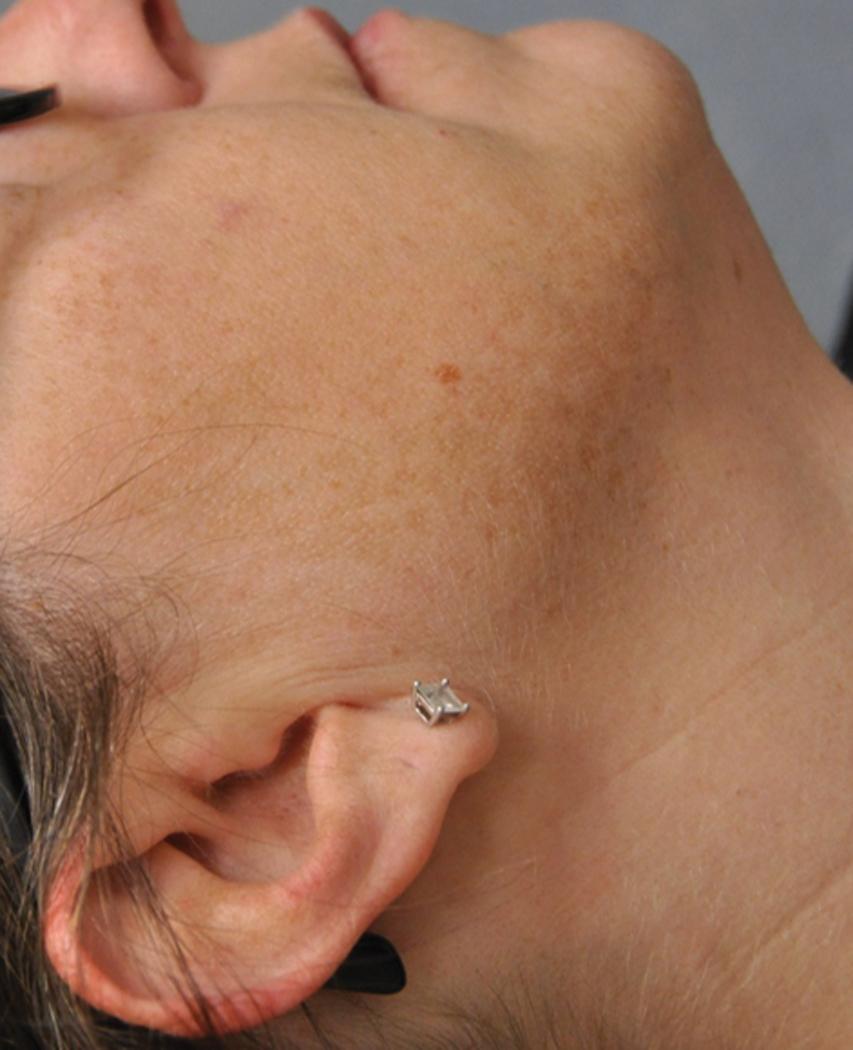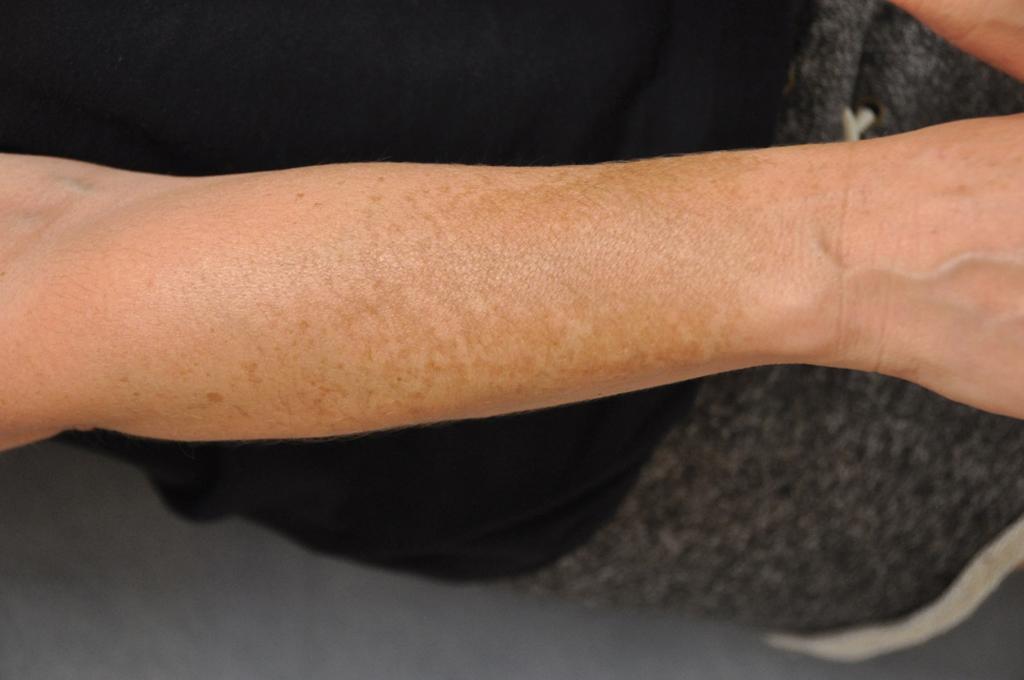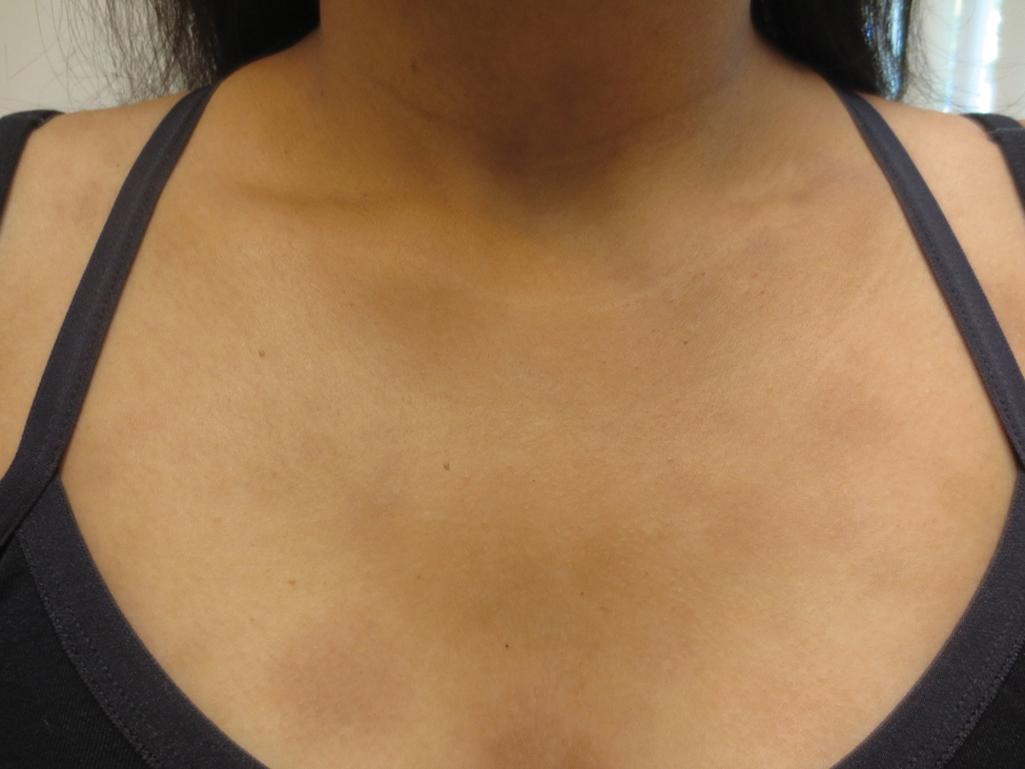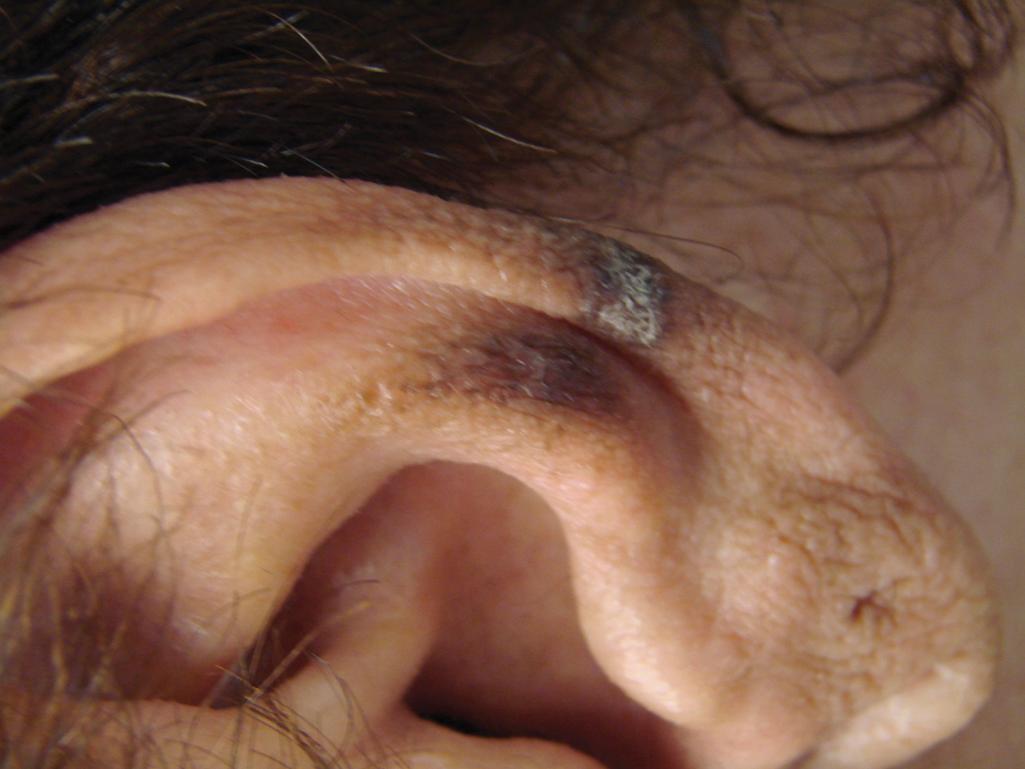Physical Address
304 North Cardinal St.
Dorchester Center, MA 02124
Casey Abrahams and Afton Chavez
Melasma is also known as “chloasma” or, colloquially, the “mask of pregnancy.” It is characterized by light to dark-brown or brown-gray patches with irregular borders that appear primarily on the face ( Fig. 7.1 ) but also on the forearms ( Fig. 7.2 ) and mid-upper chest.
A centrofacial distribution on the forehead, cheeks, nose, upper lip (sparing the philtrum), and chin is the most common pattern.
Melasma may also present in a malar (affecting the cheeks and nose) or mandibular (along the jawline) distribution.
There is an increased prevalence of melasma in young to middle-aged women with darker skin types, such as those of Hispanic, Asian, or African descent.
Exacerbating factors include ultraviolet (UV) and visible light and hyperestrogenic states, such as when pregnant or using oral contraceptives.
Patients frequently report a waxing and waning course with dramatic worsening in the summer months.


The primary differential for melasma includes drug-induced hyperpigmentation or discoloration, postinflammatory hyperpigmentation, pigmented contact dermatitis (Riehl melanosis), acquired bilateral nevus of Ota-like macules (Hori nevus), actinic lichen planus, lichen planus pigmentosus (LPP), erythema dyschromicum perstans (EDP), and exogenous ochronosis.
Drug-induced hyperpigmentation may be differentiated from melasma based on history of exposure to commonly implicated medications, such as minocycline, chemotherapeutics, antimalarials, zidovudine, heavy metals, or clofazimine. Drug-induced hyperpigmentation may be localized or generalized. Unlike melasma, the oral mucosa and nails may also be affected in drug-induced hyperpigmentation.
Postinflammatory hyperpigmentation can occur anywhere on the body and may be differentiated from melasma based on a history of prior inflammation, such as rashes or injury to the skin.
Pigmented contact dermatitis occurs after exposure to certain chemicals typically found in cosmetic products, such as dyes or fragrances, and presents in the areas in which the product has been applied.
Acquired bilateral nevus of Ota-like macules (Hori nevus) presents as multiple brown-gray-blue macules, primarily on the malar cheeks in Asian women in their fourth or fifth decade of life. If there is a question regarding the diagnosis, biopsy of Hori nevus shows dermal melanocytes.
Actinic lichen planus, LPP, and EDP are all somewhat similar and may exist on a spectrum. Actinic lichen planus typically has fine scale overlying violaceous lesions. LPP usually starts on the temples/preauricular face and neck, and patients may have concomitant lichen planus. EDP tends to occur more on sun-protected areas ( Fig. 7.3 ). Biopsy can help distinguish these conditions from melasma.

Exogenous ochronosis may be differentiated from melasma based on a history of long-term use of hydroquinone. If there is a question regarding the diagnosis, histology reveals yellow to brown banana-shaped deposits in the papillary dermis.
The diagnosis may be made based on clinical appearance if history and distribution are suggestive.
A thorough history of topical and systemic medications and UV exposure should be obtained in all patients to eliminate any exacerbating etiologies.
Patients should minimize UV exposure by avoiding tanning beds, wearing sun-protective hats and clothing, and using broad-spectrum sunscreen (ideally with an SPF greater than 30) daily.
Emerging data suggests that blocking visible light with iron oxides and supplementing with oral antioxidants, such as polypodium leucotomos, may prove beneficial in minimizing melasma.
Discontinue estrogen-containing oral contraceptives, if possible.
Hydroquinone, alone or in triple combination with a retinoid and corticosteroid, may be used for periods of up to 3 to 6 months to avoid exogenous ochronosis.
Other treatment options include azelaic acid (15%–20%); L-ascorbic acid (vitamin C; 10%–15%); kojic acid (1%–4%); topical or oral tranexamic acid (oral tranexamic acid must be used with caution given the risk for thrombogenicity); glycolic or salicylic acid peels; and targeted laser therapies.
Patients can also use camouflaging makeup to minimize the appearance of the melasma.
Even small amounts of UV exposure can exacerbate melasma, so patients must practice strict adherence to sun protection.
Extreme caution must be taken when treating melasma patients with peels or lasers. Only an experienced professional should perform these procedures on patients of darker skin types because, if conducted improperly or with the wrong laser, patients can have subsequent dyspigmentation and/or scarring.
You have melasma, a type of skin pigmentation disorder characterized by light to dark brown or brown-gray patches with irregular borders. You may notice these patches primarily on your face, but they can also be found on your forearms and mid-upper chest. If you are a young to middle-aged women with a darker skin type, you are at an increased risk for melasma.
There are many treatment and prevention options for melasma. The most important step is to minimize UV exposure by wearing sun-protective hats and clothing and applying broad-spectrum sunscreen (ideally with an SPF greater than 30) daily. Melasma is exacerbated by pregnancy and estrogen-containing oral contraceptives, so you may want to consider switching to an alternative nonestrogen-containing birth control if you are on one.
Your doctor may recommend as treatment the use of hydroquinone, azelaic acid, topical vitamin C, kojic acid, tranexamic acid, peels, or lasers. Topical hydroquinone should not be used for more than 3 to 6 months because of the risk for paradoxical worsening of the hyperpigmentation. Peels and lasers should only be performed by an experienced professional. If performed using an improper technique, hyperpigmentation can result.
Gregory Cavanagh and Afton Chavez
Lentigines are also known as “liver spots,” “age spots,” “senile freckles,” and “lentigo senilis.” They are 0.2 cm to 2 cm, well-circumscribed, round, oval, or irregularly shaped macules that vary in color from tan to dark brown or black.
Lighter lesions are typically homogenous, whereas darker ones may appear more mottled.
Dermoscopic features include a diffuse light brown structureless area, sharply demarcated and/or moth-eaten borders, finger-printing, and a reticular pattern with thin lines that are occasionally short and interrupted.
Because they are induced by UV radiation (UVR), lentigines typically occur on sun-exposed sites, such as the face, dorsal aspects of the hands and forearms, upper trunk, and shins.
Lesions persist indefinitely but may fade slightly after cessation of UV exposure or may darken with increased UV exposure.
The differential for solar lentigines includes ephelides (freckles), PUVA (psoralen and UVA) lentigo, macular seborrheic keratosis (SK), pigmented actinic keratosis (AK), lentigo maligna, simple lentigo, junctional melanocytic nevus, and large cell acanthoma.
Ephelides are typically 1 to 5 mm, light to medium brown macules. They tend to be smaller and lighter than lentigines. They often initially develop in childhood, unlike lentigines, which develop in individuals over the age of 25 and increase in incidence with increasing age. Both are oval-to-irregularly shaped macules with smooth or jagged edges and can be found on the face and arms. Unlike lentigines, however, ephelides rarely localize to the dorsal aspect of the hands.
PUVA lentigines are well-defined, hyperpigmented macules that commonly develop in individuals undergoing long-term PUVA photochemotherapy. Compared with solar lentigines, PUVA lentigines are typically darker brown with a more stellate appearance.
There is a continuum extending from solar lentigo to macular SK; however, demonstration of a keratotic surface with horn cysts is more consistent with an SK. SKs can develop anywhere, except mucous membranes, palms, and soles. SKs are tan to black in color and have a waxy, stuck-on appearance.
In contrast to solar lentigines, pigmented AKs are more likely to have a scaly, rough surface. Pigmented AKs are considered precancerous, so additional follow-up and treatment is recommended if this is suspected. Most pigmented AKs display lateral growth, and irritation and pruritis may occur.
Lentigo maligna often exhibits greater variation in pigmentation and irregularity of borders compared with solar lentigines ( Fig. 7.4 ) and may stand out in comparison with other lentigines. Lentigo maligna presents most commonly on the face. The spots grow slowly over time. On dermoscopy, rhomboid structures and gray dots can be seen in lentigo maligna lesions. These lesions should be biopsied because they are a type of melanoma.

Simple lentigines are often smaller and more heavily pigmented than solar lentigines. Additionally, they arise during childhood with less relationship to UVR exposure. Simple lentigines and solar lentigines are both brown to black in color, but simple lentigines are more symmetric and uniformly pigmented. Solar lentigines tend to arise on sun-exposed areas of the body, whereas simple lentigines can arise anywhere on the body, including the mucous membranes and palmoplantar skin. Simple lentigines present differently on mucous membranes, however; there, they frequently have irregular borders and mottled nonhomogeneous pigmentation. In the case of both generalized and localized lentiginosis, simple lentigines may or may not be associated with an underlying disorder. In this particular case, further investigation and testing may be needed.
Solar lentigines are typically less well defined and discreet than junctional melanocytic nevi but may be indistinguishable on a clinical examination.
Lentigines are typically diagnosed based on characteristic physical examination findings and a positive history of UV exposure.
Lentigines are considered a marker of excessive UV exposure; therefore patients should be monitored with regular skin examinations to screen for cutaneous malignancies.
Lesions should be monitored for growth or change. The ABCDE criteria (asymmetry, border irregularities, color variation, large diameter, and evolution of the lesion) should be implemented to screen for atypical lesions.
If atypical features are noted on an examination a biopsy is recommended for definitive diagnosis.
Solar lentigines are benign lesions that are of cosmetic concern only, but patients might desire treatment.
Preventative measures include minimizing UV exposure through the use of sunscreen, sun-protective clothing, and sun avoidance during peak hours.
Cryotherapy, chemical peels, and laser surgery have been shown to be effective. Caution must be used to prevent posttreatment dyspigmentation.
Bleaching agents, such as hydroquinone, have been shown to be ineffective.
Continued skin monitoring for cutaneous carcinomas is also indicated because solar lentigines are an indication of chronic UVR exposure.
Become a Clinical Tree membership for Full access and enjoy Unlimited articles
If you are a member. Log in here